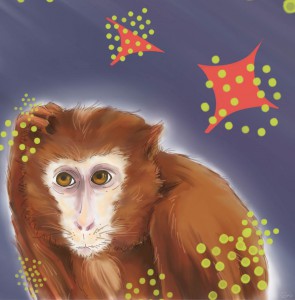Similarities of Vision and Brain Response in Macaques and Humans
 Research conducted within the Pasupathy lab at the Washington National Primate Research Center capitalizes upon the similarities of macaque and human vision and brain response in its exploration of the primate visual cortex.
Research conducted within the Pasupathy lab at the Washington National Primate Research Center capitalizes upon the similarities of macaque and human vision and brain response in its exploration of the primate visual cortex.
The primate visual system is especially adept at recognizing objects in cluttered environments where the object of interest is often partially blocked from view – occluded. Finding our keys amidst paper and books on a messy desk, spotting a friend in a crowd—these are difficult tasks that stump even the most advanced computer recognition systems. This is largely because of two reasons:
- Occlusions cause parts of objects to be hidden, making recognition challenging.
- Boundary conjunctions, a byproduct of occlusion, can produce spurious features in the retinal image that make it difficult to determine where one object ends and another begins.
Despite these difficulties, our visual system recognizes occluded objects quickly, accurately and seemingly effortlessly. How is this achieved? Research in the Pasupathy lab at the Washington National Primate Research Center tackles this question with a combination of neurophysiological recordings in monkeys trained to recognize shapes and computer modeling.
Object Recognition in Macaque and Human Visual Systems
Macaque monkeys are a great animal model to investigate object recognition because their visual system is very similar to that of humans. Monkeys and humans can easily discriminate complex images and objects that are only 2° in diameter at central fixation. Monkeys are very similar to humans in their voluntary eye-movements and their exploration of high-interest targets in scenes. Several behavioral studies in monkeys suggest that they segment visual scenes into objects and regions the way humans do. Monkey visual cortex is also similar to humans in terms of its organization into dorsal and ventral streams, and in terms of the receptive field size and tuning properties.
Recognition of Occluded (Partially Blocked) Objects
For the neurophysiological experiments, we focus on areas V4 and the inferotemporal cortex, brain regions known to play an important role in visual form processing. Recently we have also begun studies in the prefrontal cortex, which is important for the control of complex behavior, to investigate how feedback from higher cortices might play a role in the recognition under occlusion. Our computer modelling efforts help us reveal how neuronal responses in these brain areas arise from signals in earlier processing stages and how these signals solve the problem of occlusion. More recently, we have also begun a collaboration to compare the responses of neurons in visual cortex and those of units in deep convolutional nets, the current best visual recognition algorithms.
Utilization of this Research for Public Good
Past discoveries in visual neuroscience have driven advances in artificial and computer vision. Deep artificial networks now provide an important opportunity for insight from the artificial vision community to help understand the complex encoding at middle and higher levels in the primate visual cortex.
Dr. Anitha Pasupathy | Core Staff Scientist | WaNPRC Division of Neuroscience | Associate Professor Department of Biostructure